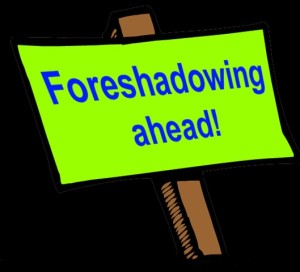By Joe Moore
HAPPY SAINT PATRICK’S DAY!
A few weeks ago we discussed flashbacks and how they allow writers to convey backstory while the scene usually remains in the present. It’s a common technique in the writer’s toolbox for filling in the important history of a character or other elements in the story.
 Today’s post is about foreshadowing, a technique that also deals with time. Most writers are familiar with it although few know about a companion technique called backshadowing. Both work well when used discretely.
Today’s post is about foreshadowing, a technique that also deals with time. Most writers are familiar with it although few know about a companion technique called backshadowing. Both work well when used discretely.
Let’s start with foreshadowing. It’s the planting of hints and clues that tip off the reader as to what may come later in the story. For example, a character who is destined to die in an automobile accident 10 pages from now could complain about the unusual icy condition of the roads as the weather gets worse.
This technique can add dramatic tension by building anticipation about what might happen later. Foreshadowing can be used to generate suspense or to get across information that helps the reader appreciate future developments. Foreshadowing can also help make believable what might otherwise be outlandish or extraordinary events. For instance, if something in a character’s background is foreshadowed (she’s afraid of heights), then the reader will be prepared when a set of circumstances occur that cause a character to panic while standing on a roof.
There are many types of foreshadowing including direct, subtle, atmospheric, and global.
Direct foreshadowing is just that; a direct piece of information that is revealed to the reader about a future event.
Her plan was to pick the lock on the rear entrance, disable the alarm and disconnect the camera feeds before grabbing the jewels.
Subtle foreshadowing is not so obvious. It can be small crumbs of information that, when added together, help believability.
He reached for the red coffee cup but hesitated, knowing that particular color always meant failure.
Atmospheric foreshadowing usually deals with the elements surrounding the character and how they might reflect a mood or situation.
She crouched behind the wall and watched the clouds move across the moon and blot out the stars. The darkness would bring death.
Global foreshadowing is usually found right up front, either at the beginning of the book or the start of a chapter.
It never occurred to him that by the end of the day, he would shoot and kill five people.
So if that’s foreshadowing, what the heck is backshadowing?
It’s usually an event that has already occurred but affects the future. A Salem witch is burnt at the stake on page 15, while hundreds of years and many pages later, a woman comments that her new Salem, Mass apartment has a lingering burning smell.
Another common use of backshadowing is to start the story with the ending, then shift back to the beginning with the reader in full knowledge of the outcome but no idea how it all happened.
That’s how I wound up dead on a beautiful fall evening. But I’m getting ahead of myself. Let’s back up and start at the beginning . . .
The reader doesn’t have to spot the foreshadowing or backshadowing when they occur, but they should be able to see their significance later.
Do you use either or both in your writing? Can you think of other types of foreshadowing and how they’re used?
Download FRESH KILLS, Tales from the Kill Zone to your Kindle or PC today.

Great post, Joe.
It never occurred to me to discuss foreshadowing today, but I must….oh soon, I must….
One of my favorite bits is the first line of Dean Koontz’s Dragon Tears:
Tuesday was another fine Southern California day, full of sunshine and promise, until Harry Lyon had to shoot someone at lunch.
Thanks, Miller. You’re not just saying that because I bought all those eggs, are you?
Jim, that’s one of my favorite openings, too. That’s like shooting the story out of a cannon. Who could resist reading on?
Thanks for the tip – count me as a first time vistor who found you via twitter and now will stop by more often.
Great information, Joe. Thanks for sharing from your toolkit.
I like the concept of backshadowing–I’ve never heard it called that before. Global foreshadowing at the beginning of a story is, as you point out, a great way to propel the story forward. Sometimes, though, I wonder if it’s not overused to the point that it becomes a cheat or a cliche, as in, “As she sipped her lemon tea that morning, Harriet had no reason to think that she would be dead by noon.” What do you think?
WPP, thanks for dropping by. See you next time.
Hi Brock, glad to be of help.
I agree, Kathryn, it can be used too much. I’ve found it used wonderfully as in Jim’s example, and I’ve also run into it where it stopped me cold. It all comes down to skill.
Love the shamrock, Joe.
I’ll always remember the scene in FATAL ATTRACTION where the camera zooms in on the knife rack (at least, I think it was FA) and you instantly think, “So we’ll be seeing a knifing later…”
I think a good use of foreshadowing is almost like a musical score that can redefine what the eyes see in a film. Of course using it badly can be just plain confusing.
re: St. Patty’s Day
People at work tried to pinch me this morning for not wearing green, I politely informed them that I am of very recent Irish descent and therefore exempt to which I added:
“Pinch me again and dorn a bhualeadh ar dhuine”
Sláinte